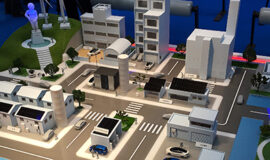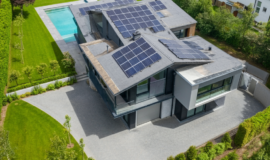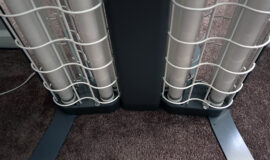Solar Power Towers
Another innovation that implements solar energy is the solar power towers or also called heliostat power plants. A solar power tower is using a large solar setup that converts energy from the sun. Solar power towers don’t use conventional solar panels but instead use concrete towers and a large number of sun-tracking mirrors for directing the solar energy towards a receiver on the concrete tower. Earlier designs heated the water in the receiver which then produces steam which in turn spins an electrical generator to produce electricity. Newer designs use liquid sodium and molten salts as working fluids. In the 1980s and 1990s, the US department of energy in California gave a statement that solar power towers can be used to power utilities all day long through electricity production and storage. And today, power towers continue to build a clean energy economy. In 2007, Abengoa Solar built the first commercially operating concentrating solar power plant. The solar tower is located in Spain and it is with an installed capacity of 11 MW. Another popular solar tower is the heliostat created by Brightsource Energy with an installed capacity of 392 MW. In 2019, they commissioned their 121 MW Ashalim tower CSP project. Brightsource Energy is joining forces with Shanghai Electric to form a 100 MW tower plant, which will also be the first to use storage. But the world’s tallest concentrated solar power tower is located in Dubai. This heliostat system is with a concrete tower with a height of 260 m and with an installed capacity of 950 MW.
Some of the advantages of solar power towers are:
– They are a renewable source of energy and no fuels are required
– They don’t pollute, they are carbon-free
– The costs for operating them are low
– They produce electricity with a high efficiency
– A big advantage of a solar power tower is that the concentration of light is onto one single receiver which yields higher temperatures
– Can serve as a drop-in replacement for conventional fuels to make steam
– Can utilize thermal storage to better match supply with demand
– The mirrors in a solar power tower system receive sunlight by sun-tracking at two axes. The advantage here is that as it can receive sunshine even when the sun is low in the sky as is the case during winter months or even at dawn and twilight. More sunshine is effectively utilized
The disadvantages on the other hand are:
– Slightly more expensive than solar PV panels
– Construction and installation costs can be high
– The manufacturing processes often create pollution
– They require a significant amount of space and therefore suitable for areas like the desert
– They involve significant transmission losses
– Heavily location dependent
– The winds can cause problems which could affect efficiency
Even though these types of systems are expensive and far from simple, solar power towers hold the promise of a green energy source that can be produced at scales comparable to coal or nuclear, under the appropriate conditions.





